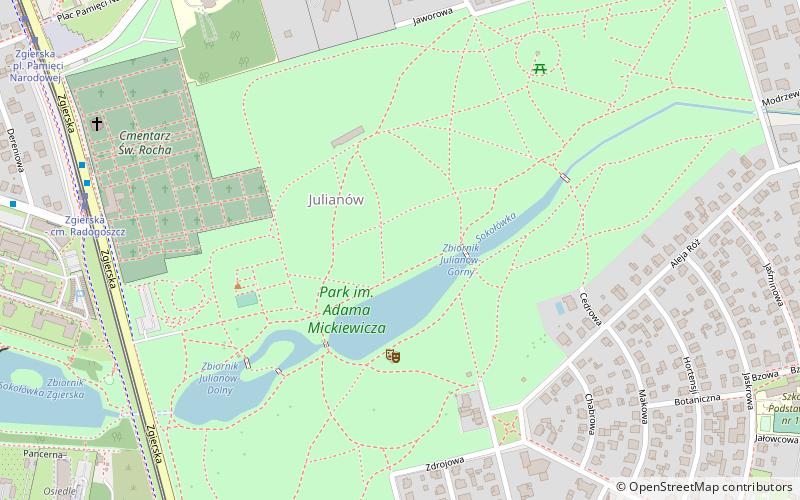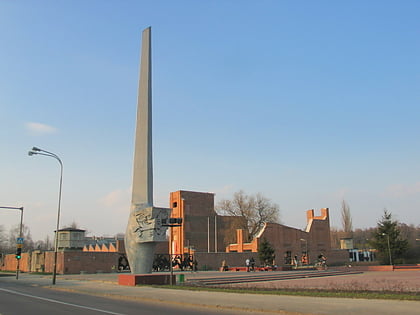Park im. Adama Mickiewicza, Łódź


Facts and practical information
Adam Mickiewicz Park - a historic park in Łódź with an area of 49.4 ha, located in the Julianów housing estate, within the limits of Zgierska, Sowińskiego, Jaworowa, Folwarczna, al. Róż, and Karłowicza streets. The park is situated in a depression, stretching along the Sokołówka river valley.
Probably in the Middle Ages there was a wooden fortified settlement here. Later the village belonged to small estates of noblemen. At the beginning of the 19th century the area of the present park became a possession of Stanisław Strzałkowski. In the 1880s the estate was auctioned off. The property was bought by Juliusz Heinzel, a factory owner from Lodz, and around 1890 he built a palace inspired by Italian Renaissance forms, overlooking the ponds. The palace was built on a hill at the end of a lime avenue, leading to the palace from Bieganski Street. Stairs from the terrace of the mansion led directly to the pond. Between the palace and the pond there was a fountain. The decoration of the park was the water pool. Next to the palace there was a game preserve and an orchard. At that time the park was reconstructed and numerous stairs, fountains, cascades, bridges and many exotic trees were planted. Most of these specimens have not survived to the present day.
In 1897 the palace and park were bought from the remaining heirs by the son of Juliusz Teodor Heinzl. The complex functioned until the 1930s. However the profligacy of the owners caused financial ruin of the family and the need to sell the palace, which in 1938 was bought by the magistrate of Lodz to be used as a regional museum. During World War II, the palace housed the headquarters of the Lodz Army, which resulted in the palace being bombed on September 6, 1939. The palace was damaged and then demolished by the German occupants. In the park, there is a boulder commemorating the soldiers who died there. Germans reconstructed the park significantly. They marked out alleys in the forest part and reduced their number in the park part. They filled in some of the ponds and replanted some of the trees, thus giving the park a plastic, landscape character.
After World War II, the park's fence was dismantled and sports facilities were located in its northeastern part. A parachute tower with a landing place, belonging to the Air Force League, and a model train track were set up in the non-wooded area. In the 1950s the ponds were rebuilt and regulated, giving them their present appearance. Their axis is the Sokołówka River. Also from this period, there is a concert shell built by the Department of Culture of the City of Lodz. The park area was enlarged by joining and developing the manor grounds. In the 1990s, the park was additionally enlarged by the area of the former warehouse bought by the city. New volleyball, basketball, and soccer fields were created there, as well as a hill for sledders and mountain bikers.
The park is adjacent to a villa estate called Julianów - from the informal name of the park.
In Mickiewicz Park there are twenty trees listed as monuments of nature. Since 1984, the park has been listed in the register of monuments of the National Heritage Institute.
Bałuty (Julianów-Marysin-Rogi)Łódź
Park im. Adama Mickiewicza – popular in the area (distance from the attraction)
Nearby attractions include: Radogoszcz prison, Cmentarz Św. Rocha, Park im. Szarych Szeregów, Centrum Tańca i Zabawy TWISTER.
Frequently Asked Questions (FAQ)
Which popular attractions are close to Park im. Adama Mickiewicza?
How to get to Park im. Adama Mickiewicza by public transport?
Tram
- Zgierska - cm. Radogoszcz • Lines: 11A, 11B, 4, 45 (8 min walk)
Bus
- Zgierska - cm. Radogoszcz • Lines: 59 (8 min walk)
- Liściasta - cm. Radogoszcz • Lines: 99 (9 min walk)
Train
- Łódź Arturówek (21 min walk)
- Łódź Warszawska (28 min walk)






